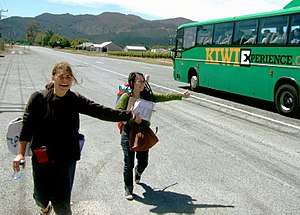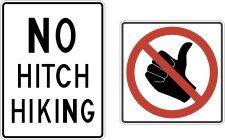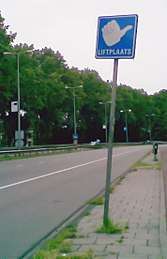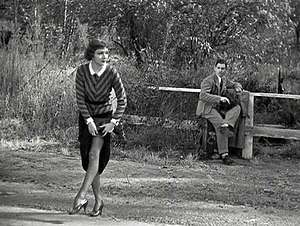Hitchhiking
Hitchhiking (also known as thumbing or hitching) is a means of transportation that is gained by asking individuals, usually strangers, for a ride in their car or other vehicle. The ride is usually, but not always, free.
_March_1936.jpg)


Itinerants have also used hitchhiking as a primary mode of travel for the better part of the last century, and continue to do so today.[1][2]
Signaling methods

- Signals used by hitchhikers
Hitchhikers use a variety of signals to indicate they need a ride. Indicators can be physical gestures or displays including written signs.[3] The physical gestures, e.g., hand signals, hitchhikers use differ around the world:
- In some African countries, the hitchhiker's hand is held with the palm facing upwards.
- In most of Europe, North America, and the United Kingdom, most hitchhikers stand with their back facing the direction of travel. The hitchhiker typically extends their arm towards the road with the thumb of the closed hand pointing upward or in the direction of vehicle travel.
- In other parts of the world, such as Australia, it is more common to use the index finger to point at the road.
- Signals used by drivers
In 1971, during the Vietnam War, drivers invented methods to communicate various messages to hitchhikers (frequently soldiers in those areas of the U.S. near military bases). To indicate to a hitchhiking soldier that their vehicles have no additional space to accommodate them, drivers could tap on the vehicle roof. Another common message that drivers could signal to hitchhikers—who usually sought to travel long distances, distances too far to walk in a reasonable amount of time—was that the driver's destinations were located nearby—and of little use to the hitchhiker—by pointing at the ground for a few seconds.
Legal status

Hitchhiking is a historically common (autonomous) practice worldwide and hence there are very few places in the world where laws exist to restrict it. However, a minority of countries have laws that restrict hitchhiking at certain locations.[4] In the United States, for example, some local governments have laws outlawing hitchhiking, on the basis of drivers' and hitchhikers' safety. In 1946, New Jersey arrested and imprisoned a hitchhiker, leading to intervention by the American Civil Liberties Union.[5] In Canada, several highways have restrictions on hitchhiking, particularly in British Columbia and the 400-series highways in Ontario. In all countries in Europe, it is legal to hitchhike and in some places even encouraged. However, worldwide, even where hitchhiking is permitted, laws forbid hitchhiking where pedestrians are banned, such as the Autobahn (Germany), Autostrade (Italy), motorways (United Kingdom and continental Europe) or interstate highways (United States), although hitchhikers often obtain rides at entrances and truck stops where it is legal at least throughout Europe [6][7] with the exception of Italy.[8]
Decline
In 2011, Freakonomics Radio reviewed sparse data about hitchhiking, and identified a decline in hitchhiking in the US since the 1970s, which it attributed to a number of factors, including lower air travel costs due to deregulation, the presence of more money in the economy to pay for travel, more numerous and more reliable cars, and a lack of trust of strangers.[9] Fear of hitchhiking is thought to have been spurred by movies such as The Texas Chain Saw Massacre (1974) and a few real stories of imperiled passengers, notably the kidnapping of Colleen Stan in California.[9] See § Safety, below.
Julian Portis points out[10] that the rise of faster highways, such as freeways, motorways, and expressways, has made hitchhiking more difficult. He adds:
The real danger of hitchhiking has most likely remained relatively constant, but the general perception of this danger has increased. ... [O]ur national tolerance for danger has gone down: things that we previously saw as reasonably safe suddenly appeared imminently threatening. This trend is not just isolated to the world of hitchhiking; it has become a pernicious artifact throughout the American cultural conscience.
Some British researchers discuss reasons for hitchhiking's decline in the UK, and possible means of reviving it in safer and more-organized forms.[11]
In recent years, hitchhikers have started efforts to strengthen their community. Examples include the annual Hitchgathering, an event organized by hitchhikers, for hitchhikers, and websites such as hitchwiki and hitchbase, which are platforms for hitchhikers to share tips and provide a way of looking up good hitchhiking spots around the world.
Safety
| Wikivoyage has some tips for safe hitchhiking. |
Limited data is available regarding the safety of hitchhiking.[12] Compiling good safety data requires counting hitchhikers, counting rides, and counting problems: a difficult task.[13]
Two studies on the topic include a 1974 California Highway Patrol study and a 1989 German federal police study.[12] The California study found that hitchhikers were not disproportionately likely to be victims of crime.[14] The German study concluded that the actual risk is much lower than the publicly-perceived risk; the authors did not advise against hitchhiking in general.[15] They found that in some cases there were verbal disputes or inappropriate comments, but physical attacks were very rare.[16]
Recommended safety practices include:[17]
- Asking for rides at gas stations instead of signaling at the roadside
- Refusing rides from impaired drivers
- Hitchhiking during daylight hours
- Trusting one's instincts
- Traveling with another hitchhiker; this measure decreases the likelihood of harm by a factor of six[18]
Around the world
Cuba
In Cuba, picking up hitchhikers is mandatory for government vehicles, if passenger space is available. Hitchhiking is encouraged, as Cuba has few cars, and hitch hikers use designated spots. Drivers pick up waiting riders on a first come, first served basis.[19]
Israel
In Israel, hitchhiking is commonplace at designated locations called trempiyadas (טרמפיאדה in Hebrew, derived from the “German” trampen). Travelers soliciting rides, called trempists, wait at trempiyadas, typically junctions of highways or main roads outside of a city.
Nepal
In Nepal, hitchhiking is very common in rural areas. Many do not own cars so hitchhiking is a common practice especially in and around villages.
Netherlands

In the Netherlands, hitchhiking is legal and official signs indicate where one may wait for a ride. These designated hitchhiking locations are called liftershalte or liftplaats in Dutch, and they are particularly common in university towns.[20][21]
Poland
Hitchhiking in Poland has a long history and is still popular. It was legalised and formalised in 1957 so hitchhikers could buy booklets including coupons from travel agencies.[22] These coupons were given to drivers who took hitchhikers. By the end of each season drivers who collected the highest number of coupons could exchange them for prizes, and others took part in a lottery. This so-called "Akcja Autostop" was popular till the end of the 1970s, but the sale of the booklet was discontinued in 1995.[23]
Ireland
Hitchhiking in Ireland is legal, unless it takes place on motorways. A backpacker will most likely still get a lift if the car has enough space to park. Local police (Gardaí) usually let backpackers get away with a verbal warning.[24]
United States
Hitchhiking became a common method of traveling during the Great Depression.

Warnings of the potential dangers of picking up hitchhikers were publicized to drivers, who were advised that some hitchhikers would rob drivers and, in some cases, sexually assault or murder them. Other warnings were publicized to the hitchhikers themselves, alerting them to the same types of crimes being carried out by drivers. Still, hitchhiking was part of the American psyche and many people continued to stick out their thumbs, even in states where the practice had been outlawed.[25]
Today, hitchhiking is legal in 44 of the 50 states,[26] provided that the hitchhiker is not standing in the roadway or otherwise hindering the normal flow of traffic. Even in states where hitchhiking is illegal, hitchhikers are rarely ticketed. For example, the Wyoming Highway Patrol approached 524 hitchhikers in 2010, but only eight of them were cited (hitchhiking was subsequently legalized in Wyoming in 2013).[27]
In several urban areas, a variation of hitchhiking called slugging occurs, motivated by HOV lanes.[28]
In popular culture

Film
- 1931 – Parlor, Bedroom and Bath
- 1934 – It Happened One Night
- 1934 – Bright Eyes
- 1935 – Bordertown
- 1935 – Diamond Jim
- 1936 – The Petrified Forest
- 1936 – Love on the Run
- 1937 – She Was an Acrobat's Daughter
- 1937 – Way Out West
- 1938 – Man-Proof
- 1939 – Le Dernier Tournant
- 1940 – The Grapes of Wrath
- 1940 – Cross-Country Romance
- 1941 – The Bride Came C.O.D.
- 1941 – Sullivan's Travels
- 1943 – Ossessione
- 1944 – The Seventh Cross
- 1945 – Eve Knew Her Apples
- 1945 – Detour
- 1946 – The Postman Always Rings Twice
- 1947 – Dark Passage
- 1949 – Champion
- 1950 – Gun Crazy
- 1953 - The Hitch-Hiker
- 1956 – You Can't Run Away from It
- 1957 – A Face in the Crowd
- 1959 – Some Like it Hot
- 1963 – It's a Mad, Mad, Mad, Mad World
- 1967 – In the Heat of the Night
- 1967 – Bonnie and Clyde
- 1967 – Two for the Road
- 1967 – In Cold Blood
- 1969 – The Big Bounce
- 1969 – Chastity
- 1969 – Easy Rider
- 1970 – Five Easy Pieces
- 1971 – Podróż za jeden uśmiech (Eng. The Travel for One Smile) – popular Polish series
- 1973 – Breezy/
- 1973 – Scarecrow
- 1973 – Save the Tiger
- 1974 – Harry and Tonto
- 1974 – The Texas Chain Saw Massacre
- 1975 – Aloha, Bobby and Rose
- 1976 – Gus
- 1977 – Hitch-Hike
- 1979 – The Jerk
- 1980 – Melvin and Howard
- 1981 – The Postman Always Rings Twice
- 1981 – Gregory's Girl
- 1981 – Roadgames
- 1981 – An American Werewolf in London
- 1982 – First Blood
- 1983 – Going Back
- 1985 – Pee-wee's Big Adventure
- 1985 – The Journey of Natty Gann
- 1985 – The Sure Thing
- 1986 – The Hitcher
- 1987 – The Hitchhiker
- 1989 – Kiki's Delivery Service
- 1990 – Nouvelle Vague
- 1993 – The Fugitive
- 1994 – Forrest Gump
- 1994 – The Shawshank Redemption
- 1994 – Dumb and Dumber
- 1994 – Even Cowgirls Get the Blues
- 1995 – Showgirls
- 1998 – There's Something About Mary
- 1999 – Dogma
- 2000 – Duets
- 2000 – O Brother, Where Art Thou?
- 2001 – 3000 Miles to Graceland
- 2001 – Jay and Silent Bob Strike Back
- 2003 – The Hitcher II: I've Been Waiting
- 2003 – Suburban Virgin
- 2003 – The Haunted Mansion
- 2004 – EuroTrip
- 2004 – Crash
- 2004 – Riding the Bullet
- 2005 – Are We There Yet?
- 2005 – The Hitchhiker's Guide to the Galaxy
- 2006 – Borat: Cultural Learnings of America for Make Benefit Glorious Nation of Kazakhstan
- 2007 – No Country for Old Men
- 2007 – The Hitcher
- 2007 – Mr. Bean's Holiday
- 2007 – Into the Wild
- 2007 – Have Dreams, Will Travel
- 2008 – The Yellow Handkerchief
- 2011 – Hick
- 2012 – The Angels' Share
- 2013 – Man of Steel
- 2013 – Inside Llewyn Davis
- 2014 – Wild
- 2015 – Minions
- 2016 – Pee-wee's Big Holiday
- 2016 – The Fundamentals of Caring
- 2017 – My Friend Dahmer
Literature
- 1939 – The Grapes of Wrath, by John Steinbeck, opens with a hitched ride.
- 1957 – Jack Kerouac immortalized hitchhiking in his book, On the Road.
- 1971 – Ken Welsh's "how to" book on hitchhiking around Europe, titled Hitch-hiker's Guide to Europe, is rumored to have inspired the title of Douglas Adams' 1978 classic book.
- 1973 – Kurt Vonnegut's perpetual protagonist, Kilgore Trout, hitchhikes halfway across the country in Breakfast of Champions (also known as Goodbye Blue Monday).
- 1976 – Sissy Hankshaw, the protagonist of Even Cowgirls Get the Blues by Tom Robbins, becomes legendary as a hitchhiker in part because of her unusually large thumbs.
- 1977 – "The Hitch-Hiker", by Roald Dahl
- 1978 – In his cult classic The Hitchhiker's Guide to the Galaxy (first broadcast on radio in 1978), Douglas Adams postulated on interstellar hitchhiking.
- 1984 – Science fiction author Robert A. Heinlein described interdimensional hitchhiking in his book Job: A Comedy of Justice.
- 1996 – Into the Wild by Jon Krakauer
- 2001 – Round Ireland with a Fridge by British comedian Tony Hawks: hitchhiking around Ireland with a refrigerator, as a result of a drunken bet.
- 2003 – Evasion by CrimethInc.
- 2005 – No Such Thing As A Free Ride? is a comprehensive anthology of hitchhiking stories and viewpoints, serialized in The Times and named The Observer's Travel Book of the Week. Edited by Tom Sykes and Simon Sykes, it featured contributions from Mike Leigh, Sir Alan Parker, Sir Max Hastings, Tony Hawks and Eric Burdon, amongst others. In 2008, No Such Thing As A Free Ride? North American Edition was published by Goose Lane of Canada and featured JP Donleavy, Margaret Avison, Doug Stanhope, and Will Durst, amongst others.
- 2006 – Riding With Strangers: A Hitchhiker's Journey by Elijah Wald
- 2009 – Le Monde en stop by Ludovic Hubler
- 2010 – Hitchhiking in the Axis of Evil - By thumb in Iraq, Iran and Afghanistan by Juan Pablo Villarino
- 2019 – The Hitchhiker Man - In June of 2007 Matt Fox left his middle class life behind to go hitchhiking. This is his story. by Matt Fox
Music
Television
- 1960 – "Hitch-Hike", an episode of Alfred Hitchcock Presents based on a short story by Ed Lacy
- 1960 – "The Hitch-Hiker", an episode of The Twilight Zone
- 1981 – The Hitchhiker's Guide to the Galaxy TV series
- 1983 – Andrea's Story: A Hitchhiking Tragedy, an ABC Afterschool Special presentation
- 1983 - Quincy, M.E. episode "Beyond the Open Door"
- 1984 – Diff'rent Strokes, a two-part very special episode, "The Hitchhikers"
- 1999 – SpongeBob SquarePants – "Pizza Delivery"
- 2000 – "The Hitch-hiker", an episode of Tales of the Unexpected
- 2003 – Cold Case episode 1.10, "Hitchhiker", addresses similar murders of hitchhikers in Pennsylvania, Delaware, and New Jersey
- 2004 – The L Word episode "Losing It"
- 2006 – The Masters of Horror episode "Pick Me Up"
- 2007 – Peking Express, a Dutch/Flemish reality game show that follows a series of couples as they hitchhike to or from Beijing (in seasons 1–3) and South America (in seasons 4 and 5)
Notable hitchhikers

Numerous victims on the Highway of Tears disappeared while hitchhiking. Notable individual hitchhikers include:
- Joe Bennett – New Zealand newspaper columnist and author; hitchhiked around the world for 10 years[29]
- André Brugiroux – from France; hitchhiked all around the world for 18 years, from 1955 to 1973
- David Choe – painter, muralist, graffiti artist and graphic novelist, spent two years hitchhiking
- Martin Clark and Graham Beynon – last hitchhikers recorded in the Guinness Book of Records for the Land's End to John O'Groats trip (17 hours 8 minutes)
- W. H. Davies – Welsh poet and tramp, who hitchhiked America during the early 20th century
- hitchBOT – Canadian hitchhiking robot[30]
- Sascha Grabow – from Germany; hitchhiked in all but three of the world's 193 countries
- Ludovic Hubler – French hitchhiker who toured the world entirely by hitchhiking from 1 January 2003 to 1 January 2008, and wrote Le Monde en stop about his experiences
- Ilmar Island (Saar) – the last and only hitchhiker recorded in the Guinness Book of Records for hitching between Key West, Florida and Fairbanks, Alaska (5 days, 20 hours and 52 minutes); the category only appeared once.[31]
- Jack Kerouac – Beat Generation author who hitchhiked in America and wrote many books about his experience
- Chris McCandless – subject of the book Into the Wild and related films; hitchhiked throughout the western region of North America in the early 1990s
- Robert Prins – last hitchhiker recorded in the Guinness Book of Records for the 24-hour hitchhiking record (2,318.4 km)[32]
- Stephan Schlei – from Ratingen, Germany; hitchhiked more than 621,371 mi (1,000,000 km); the Guinness Book of Records, before all hitchhiking records were removed, once said that he was the World's No. 1 Hitchhiker[33]
- Devon Smith – listed in the Guinness Book of World Records for most cumulative miles hitchhiked (1973 to 1985), over 290,988 mi (468,300 km); held the record for hitchhiking all 48 contiguous US states in 33 days during 1957[34]
- Colleen Stan, who was kidnapped by Cameron and Janice Hooker, and tortured and abused for seven years before Janice helped her escape.[35]
- Andrzej Stasiuk – writer, journalist and literary critic[36]
- John Waters – filmmaker, writer, actor and artist; author of Carsick: John Waters Hitchhikes Across America[37]
- Nedd Willard – writer, artist and journalist
Notable fictional hitchhikers
- Hitchhiker – a hitchhiking lunatic killer played by actor Edwin Neal in the original film, The Texas Chain Saw Massacre (1974)
- Alan Parker, in Stephen King's horror novella, Riding the Bullet (2000)
- Phineas, Ezra and Gus – the Hitchhiking Ghosts considered the mascots of the Haunted Mansion attraction, who also appear in other media, such as Disney's House of Mouse, The Haunted Mansion movie, and official merchandise
- Ford Prefect – a space-hitchhiking travel writer in The Hitchhikers Guide to the Galaxy
- The hitchhiker, in Stephen King's short story, "Mute" (2012)
- The Hitcher – a green cockney man who was featured in The Mighty Boosh
- Cissy Hankshaw - a young hitchhiker with special outsized thumbs, from Even Cowgirls Get the Blues by Tom Robbins
See also
- Carpool
- Flexible carpooling – hitchhiking formalized via designated meeting points
- Freighthopping
- Hitchwiki
- Real-time ridesharing – hitchhiking facilitated by a smartphone application
- Slugging – hitchhiking motivated by HOV lanes in several urban areas
References
Notes
- Hitch The World | ...indefinite vagabond travel
- Velabas – Travel Narrative and Drawings from Hitchhiking Around the World
- Kovalchik, Kara (9 January 2015). "Why Do Hitchhikers Say "(Destination)...Or Bust!"?". Mental Floss.
- Nwanna, p.573
- "So You Won't Talk, Huh?". Time. 18 November 1946. Retrieved 27 January 2009.
In her cell, Susan learned that it also (technically) forbids hitchhiking, and demands (by a law passed in 1799) that strangers be able to give a good account of themselves.... Attorney James A. Major of the American Civil Liberties Union demanded that she be given a new trial.
- Hitchhiking Basics
- Hitchhiking
- http://hitchwiki.org/en/Italy
- Huynh, Diana (10 October 2011). "Where Have All the Hitchhikers Gone?". Freakonomics Radio Podcast. Retrieved 21 September 2016.
- Compagni Portis, Julian (2015). Thumbs Down: America and the Decline of Hitchhiking (BA thesis). Wesleyan University.
- Chesters, Graeme; Smith, David (2001). "'The Neglected Art of Hitch-hiking: Risk, Trust and Sustainability". Sociological Research Online. 6 (3).
- Wechner, Bernd (1 March 2002). "A dearth of research: Does anyone really know anything about hitch-hiking?". bernd.wechner.info. Archived from the original on 27 September 2013. Retrieved 9 February 2017.
- Wechner, Bernd (1 November 1996). "The Pros and Cons of Hitch-Hiking". bernd.wechner.info. Archived from the original on 3 March 2016. Retrieved 9 February 2017.
There are no statistics on hitch-hiking, at least none that are meaningful and reliable. Compiling useful statistics would require counting hitchers and the amount of rides they receive, and the comparing them to the problems reported, which would be a difficult task.
- McLeod, Jamie (10 January 2007). "The 'better' Better Way". The Eyeopener. Retrieved 3 May 2013.
The most recent hard evidence I could find about hitchhiking danger was a 1974 study conducted by the California Highway Patrol examining crimes committed by and on hitchhikers. It found that in 71.7 per cent of hitchhiker related crimes the hitchhiker was the victim. It also found that only 0.63 per cent of the crimes reported during the period of the study were hitchhiker-related, and that hitchhikers were not disproportionately victims of crime.
Citing: "California Crimes And Accidents Associated With Hitchhiking". California Highway Patrol. February 1974. Archived from the original on 29 June 2016. Retrieved 9 February 2017.No independent information exists about hitchhikers who are not involved in crimes. Without such information, it is not possible to conclude whether or not hitchhikers are exposed to high danger. However, the results of this study do not show that hitchhikers are over-represented in crimes or accidents beyond their numbers.
Also available as a PDF. - Joachim Fiedler; et al. (1989). Anhalterwesen und Anhaltergefahren: unter besonderer Berücksichtigung des "Kurztrampens" (in German). Wiesbaden, Germany: Bundeskriminalamt Wiesbaden. OCLC 21676123.
- "Trampen ohne großes Risiko". Zeit Online. 1990. "In one of 10,000 rides, a woman is raped and in two of 1,000 rides, there is an attempted rape."
- "Hitchhiker's safety". Hitchwiki. Retrieved 1 January 2014.This is a link to the referenced article; but, note that it has not been fully peer-reviewed, and that we cannot guarantee its validity.
- Based on: Compagni Portis, Julian (2015). Thumbs Down: America and the Decline of Hitchhiking (BA thesis). Wesleyan University. p. 44. Citing: "California Crimes And Accidents Associated With Hitchhiking". California Highway Patrol. February 1974. Table 18. Archived from the original on 29 June 2016. Retrieved 9 February 2017. Also available as a PDF.
- Cuba Hitchhiking Guide Archived 27 November 2012 at the Wayback Machine
- Frank Verhart. Lifts (ad-hoc carpooling) in Netherlands. 2007.
- The Liftershalte: Hitchhiking in the Netherlands.
- booklets
- Jakub Czupryński (red.), "Autostop polski. PRL i współczesność", Korporacja Ha!art, Kraków 2005. ISBN 83-89911-18-3
- "Ireland - Hitchwiki: the Hitchhiker's guide to Hitchhiking". hitchwiki.org. Retrieved 1 December 2016.
- Dooling, Michael C. (2010). Clueless in New England: The Unsolved Disappearances of Paula Welden, Connie Smith and Katherine Hull. The Carrollton Press.
- "United States of America - Hitchwiki: the Hitchhiker's guide to Hitchhiking". hitchwiki.org. Retrieved 9 November 2017.
- Laura Hancock (13 January 2013). "Wyoming Senate committee debates, advances hitchhiking bill". Casper Star-Tribune. Retrieved 30 May 2014.
- Falkenberg, Lisa (2 July 2007). "Slugs avoid the slow lane". Houston Chronicle.
- Bennett, Joe (2000). "A thumb in the air". Fun Run and other Oxymoron's. Simon & Schuster UK Ltd. ISBN 0684861364.
- Madrigal, Alexis C. (12 June 2014). "Meet the Cute, Wellies-Wearing, Wikipedia-Reading Robot That's Going to Hitchhike Across Canada". The Atlantic.
- Guinness Book of Records, 1980, page 466
- Guinness Book of Records, 1991, page 179
- "Stephan Schlei". Encyclopedia of Road Subculture. digihitch.com. Retrieved 14 October 2011.
- "Encyclopedia of Road Subculture: Devon Smith". Retrieved 14 October 2011.
- Green, Jim B. (2009). Colleen Stan: The Simple Gifts of Life. Dubbed by the Media "The Girl in the Box" and "The Sex Slave". iUniverse. ISBN 978-1-4401-1837-1.
- Marek Radziwon – Rozmowa z Andrzejem Stasiukiem
- Waters, John. Carsick: John Waters Hitchhikes Across America. US: MacMillan. Archived from the original on 31 July 2014. Retrieved 18 May 2015.
Bibliography
- Nwanna, Gladson I. (2004). Americans Traveling Abroad: What You Should Know Before You Go, Frontier Publishers, ISBN 1890605107.
External links
| Wikimedia Commons has media related to Hitchhiking. |




- Hitchhiking at Curlie